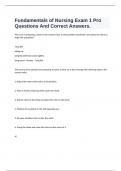Fundamentals of Nursing Exam 1 Pro
Questions And Correct Answers.
The nurse is preparing a client to be turned in bed. In what position would the nurse place the client to
begin this procedure?
lying flat
sitting up
lying flat with feet raised slightly
lying prone - Answer lying flat
The nurse and an assistant are preparing to move a client up in bed. Arrange the following steps in the
correct order.
1. Adjust the head of the bed to a flat position.
2. Place a friction-reducing sheet under the client.
3. Ask the client to bend legs and place the chin on the chest.
4. Position the assistant on the side opposite you.
5. Remove all pillows from under the client.
6. Grasp the sheet and move the client on the count of 3.
A)
,3, 1, 2, 4, 5, 6
B)
1, 2, 4, 3, 5, 6
C)
1, 5, 4, 2, 3, 6
D)
3, 2, 1, 4, 6, 5
E)
1, 3, 2, 4, 5, 6 - Answer Ans:
C
What nursing organization first legitimized the use of the nursing process?
A)
National League for Nursing
B)
American Nurses Association
,C)
International Council of Nursing
D)
State Board of Nursing - Answer B)
American Nurses Association
A female patient who is receiving chemotherapy for breast cancer tells the nurse, "The treatment for this
cancer is worse than the disease itself. I'm not going to come for my therapy anymore." The nurse
responds by using critical thinking skills to address this patient problem. Which action is the first step the
nurse would take in this process?
a. The nurse judges whether the patient database is adequate to address the problem.
b. The nurse considers whether or not to suggest a counseling session for the patient.
c. The nurse reassesses the patient and decides how best to intervene in her care.
d. The nurse identifies several options for intervening in the patient's care and critiques the merit of each
option. - Answer c. The first step when thinking critically about a situation is to identify the purpose or
goal of your thinking. Reassessing the patient helps to discipline thinking by directing all thoughts toward
the goal. Once the problem is addressed, it is important for the nurse to judge the adequacy of the
knowledge, identify potential problems, use helpful resources, and critique the decision.
The nursing process ensures that nurses are person centered rather than task centered. Rather than
simply approaching a patient to take vital signs, the nurse thinks, "How is Mrs. Barclay today? Are our
nursing actions helping her to achieve her goals? How can we better help her?" This demonstrates which
characteristic of the nursing process?
a. Systematic
b. Interpersonal
c. Dynamic
, d. Universally applicable in nursing situations - Answer b. Interpersonal. All of the other options are
characteristics of the nursing process, but the conversation and thinking quoted best illustrates the
interpersonal dimension of the nursing process
An experienced nurse tells a beginning nurse not to bother studying too hard, since most clinical
reasoning becomes "second nature" and "intuitive" once you start practicing. What thinking below
should underlie the beginning nurse's response?
a. Intuitive problem solving comes with years of practice and observation, and novice nurses should base
their care on scientific problem solving.
b. For nursing to remain a science, nurses must continue to be vigilant about stamping out intuitive
reasoning.
c. The emphasis on logical, scientific, evidence-based reasoning has held nursing back for years; it is time
to champion intuitive, creative thinking!
d. It is simply a matter of preference; some nurses are logical, scientific thinkers, and some are intuitive,
creative thinkers. - Answer a. Beginning nurses must use nursing knowledge and scientific problem
solving as the basis of care they give; intuitive problem solving comes with years of practice and
observation
The nurse uses blended competencies when caring for patients in a rehabilitation facility. Which
examples of interventions involve cognitive skills? Select all that apply.
a. The nurse uses critical thinking skills to plan care for a patient.
b. The nurse correctly administers IV saline to a patient who is dehydrated.
c. The nurse assists a patient to fill out an informed consent form.
d. The nurse learns the correct dosages for patient pain medications.
e. The nurse comforts a mother whose baby was born with Down syndrome.
f. The nurse uses the proper procedure to catheterize a female patient. - Answer a, d. Using critical
thinking and learning medication dosages are cognitive competencies. Performing procedures correctly
is a technical skill, helping a patient with an informed consent form is a legal/ethical issue, and
comforting a patient is an interpersonal skill.
A nurse uses critical thinking skills to focus on the care plan of an older adult who has dementia and
needs placement in a long-term care facility. Which statements describe characteristics of this type of
critical thinking applied to clinical reasoning? Select all that apply.
a. It functions independently of nursing standards, ethics, and state practice acts.




